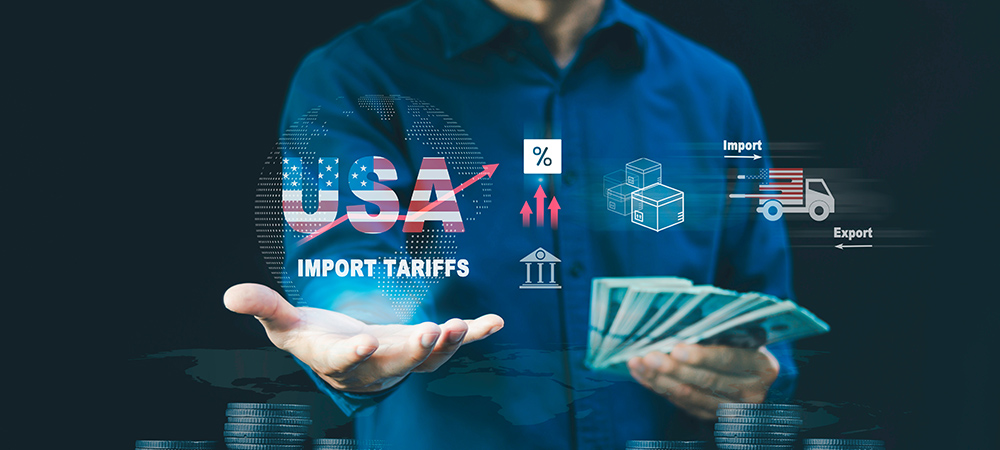Donald Trump’s tariffs are changing the way global trade operates. Countries are all feeling varying effects from the charges, including the Middle East and North Africa region and none more so than the small and medium enterprises (SMEs) in this region. Rana Abu Nemeh, Economist and Global Strategist, explores how the tariffs are affecting the MENA region and how SMEs are fighting back.
When Washington sneezes, MENA’s small businesses catch the flu. That’s the uneasy reality now playing out across boardrooms in Casablanca, factory floors in Sfax and investor pitch rooms in Riyadh. A new wave of US tariffs – aggressive in scale and unapologetically targeted –has thrown a wrench into the global trade gears, and it’s the Middle East and North Africa’s SMEs that are being crushed under the weight.
This isn’t just an economic ripple effect. It’s a full-blown trade quake shaking the very foundations of a regional sector already fighting for capital, scale and global relevance.
A shock to the system
The US tariff regime, enacted in late March under the banner of ‘strategic economic resilience’, has imposed sweeping levies ranging from 10% to 50% on a range of non-energy imports. While MENA’s oil and gas sectors remain largely insulated – thanks to decades of geopolitical entrenchment – it’s the region’s lesser-publicised but economically vital SMEs that are now exposed and vulnerable.
These are the businesses driving innovation in tech, fashion, food exports and industrial manufacturing. They represent over 90% of active enterprises across the region and contribute significantly to employment and GDP diversification.
Yet in Washington’s race to protect domestic jobs and reignite US manufacturing, MENA’s entrepreneurial middle class has become collateral damage.
Not just a cost problem – a confidence crisis
In Jordan, garment exporters that had previously enjoyed duty-free access to US markets under the 2000 Free Trade Agreement now face tariffs of up to 20%. In Tunisia, that figure rises to nearly 30% – jeopardising what was one of the region’s few non-energy trade surpluses. Even in the relatively resilient Gulf markets, a 10% tariff on aluminium and petrochemicals has sent shockwaves through high-volume export models reliant on razor-thin margins.
The impact has been swift and merciless. Manufacturing costs are rising, logistics chains are breaking, and investor sentiment is sliding.
“Tariffs are just the tip of the spear,” said Nader Abboud, a logistics CEO based in Dubai. “The real damage is in confidence. Investors are freezing deals. Banks are re-evaluating risk. And for SMEs, that’s lethal.”
The global chain is only as strong as its smallest link
Unlike multinational corporations, SMEs lack the diplomatic weight and capital buffers to absorb systemic shocks. For many, the tariff hike represents a sudden and unaffordable spike in operational costs. Inventory is being held at customs, shipping contracts are falling apart and planned US expansions are being scrapped.
One Tunis-based electronics exporter told us: “We spent two years building a relationship with a US retail chain. One policy meeting in D.C. ended it in a day.”
Supply chains that once functioned on tight schedules and competitive pricing are now being re-routed, delayed or abandoned altogether. The result? A cascading failure of trust, contracts and continuity.
Funding freeze: A dangerous slowdown in the capital flow
MENA’s SME funding scene had been slowly gaining ground since the pandemic, with growth-stage start-ups finally seeing interest from regional venture capital and sovereign wealth funds. That momentum is now stalling.
Private equity firms are holding off on regional deals. Angel investors are prioritising lower-risk geographies. Even government-backed initiatives are shifting their focus toward internal market stabilisation rather than outbound trade support.
The consequence is chilling: businesses poised for growth are now reverting to survival mode. Hiring plans are suspended. New product development is paused. And founders are once again being forced to bootstrap through another global crisis they didn’t cause.
Turning the tide: How SMEs are fighting back
But here’s where the narrative gets interesting. Far from folding under pressure, many MENA SMEs are pivoting with agility that multinationals can only envy.
First, we’re seeing a clear pivot in trade orientation – from West to East. With the US looking increasingly unreliable as a trade partner, companies are now exploring high-growth markets in Southeast Asia, Sub-Saharan Africa and Latin America. These new corridors – tariff-free and growth-hungry – could reshape the next decade of MENA trade strategy.
Second, Digital Transformation is no longer a buzzword; it’s a survival tool. E-commerce platforms, cloud-based ERPs and virtual B2B showrooms are being deployed across regional markets. Businesses that once relied on physical trade shows in New York are now closing deals via LinkedIn, Zoom and Blockchain-enabled smart contracts.
Finally, we’re seeing an early-stage renaissance in local sourcing and intra-MENA trade. From Morocco’s autoparts suppliers to Egypt’s food processors, SMEs are now recalibrating supply chains to prioritise regional partners, shortening lead times and sidestepping global tariff risks.
Government in the hot seat
Policy response so far has been sluggish, but pressure is mounting. Business associations across Jordan, Egypt and the UAE are demanding action – from subsidy packages and emergency credit to trade insurance and fast-track customs for intra-regional goods.
The Arab Monetary Fund is currently reviewing proposals for an SME-focused stabilisation fund, while the Gulf Cooperation Council is said to be exploring a regional tariff-offset mechanism to support export-heavy industries.
What’s clear is that the old model, built on Western market access and delayed policy intervention, is no longer viable. MENA’s governments must evolve from reactive regulators to proactive enablers. Otherwise, the region risks losing an entire generation of entrepreneurs.
Is this the breaking point or the breakthrough?
This moment in global trade is more than a policy debate – it’s a defining test of resilience, relevance and reform. For too long, MENA’s SMEs have been caught between the promise of globalisation and the politics of power. The new US tariffs have exposed just how fragile that balance really was.
But crises have a way of creating clarity. The SMEs that survive this moment will do so not because of tariffs avoided, but because of bold strategies deployed. They’ll be more digital, more diversified and more regionally rooted than ever before.
And maybe, just maybe, that’s what it will take for MENA to stop playing catch-up – and start setting the terms of global trade engagement on its own.
Globalisation is not dead, but it is being rewritten. And in that rewriting, MENA’s SMEs have a chance to move from the footnotes of trade agreements to the frontlines of economic transformation.




